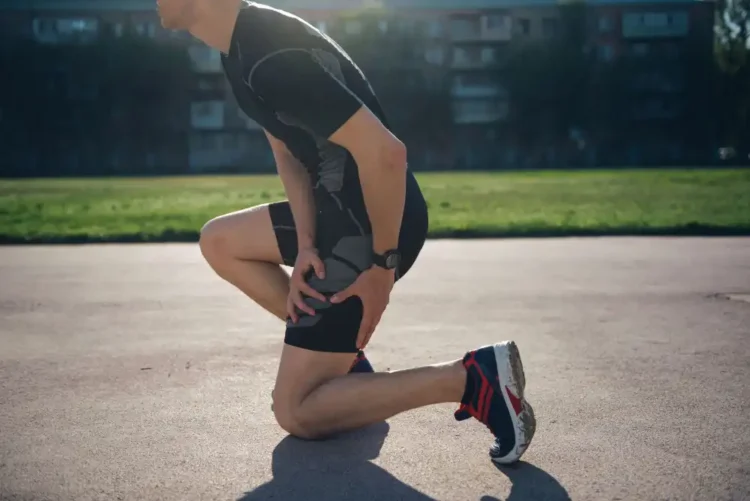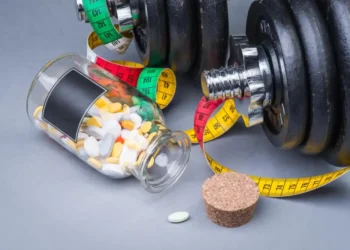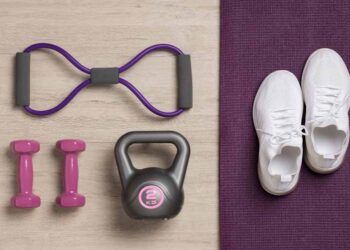Do you know that using active recovery methods can help runners heal faster after a run? It’s a key part of training for anyone who loves to hit the pavement. This time off allows the body to fix itself, gaining strength for the next adventure. With active recovery, you can make your body stronger, perform better, and avoid injuries.
Key Takeaways:
- Active recovery techniques are vital for enhancing post-run healing and preventing injuries.
- Rest days and active recovery help prevent overuse injuries, reduce inflammation, and improve performance.
- Post-run stretches, foam rolling exercises, injury prevention strategies, recovery nutrition, and using the right recovery gear are crucial components of an effective recovery routine.
- Proper rest and recovery are just as important as the runs themselves.
- By prioritizing recovery, runners can stay healthy, motivated, and ready to tackle their next run.
The Importance of Recovery for Runners
Recovery is key for runners. It lets the body fix and grow stronger after running. By using active recovery, runners can get better, avoid too much harm, reduce swelling, and do better in general.
Rest is vital in a runner’s schedule. It lets the body rest and get well. During these times, the body fixes itself, refilling muscle energy, fixing tissues, and preparing for more running.
Active recovery means doing easy exercises that help with blood flow, cut muscle ache, and get rid of waste. By adding these to their routine, runners help their muscles heal faster and stay safe from injuries.
Rest and active recovery also stop injuries from overuse. If runners don’t rest enough, they might get hurt by doing too much. Taking time off and doing light exercises can help them avoid these problems.
Also, rest and active recovery lessen body swelling. Too much running can make muscles and joints swollen, making it hard to keep going. Relaxing and doing other exercises, like swimming or yoga, can cut down on this swelling.
“Rest when you’re weary. Refresh and renew yourself, your body, your mind, your spirit. Then get back to work.” – Ralph Marston
Along with the physical side, rest has big mental benefits. Long runs can be stressful. Taking regular breaks helps runners stay mentally strong, lower stress, and keep motivated.
In short, both rest and active recovery are crucial for runners. They help improve their running, protect from injuries, and ensure long success. By caring about recovery as much as training, runners can perform their best.
| Benefits of Recovery for Runners |
|---|
| Prevents overuse injuries |
| Reduces inflammation |
| Aids in muscle repair and growth |
| Maintains mental and emotional well-being |
| Enhances overall performance |
Post-Run Stretches for Active Recovery
After running, it’s vital to focus on active recovery. This helps your muscles heal and prevents them from getting too stiff. Doing stretches after running can really benefit you. They make tight muscles longer, boost flexibility, and lower muscle pain. This means you recover faster and have a lower chance of getting hurt. Let’s look at some stretches that work well for runners.
Dynamic Stretches
Dynamic stretches are about moving in ways you do when running. They get your muscles warm and blood flowing. Adding them to what you do after running gets different muscle groups working. This makes your recovery time shorter. Here are some examples:
- Leg Swings: Stand near a wall. Swing one leg forward and backward smoothly. Do this 10-12 times on each side.
- Walking Lunges: Step ahead with one foot and bend both knees until they form a right angle. Push back off your front foot and switch legs. Do this 10-12 times on each side.
- High Knees: Run in place, lifting your knees as high as they can go. Aim to touch your palms with your knees. Keep this up for 30 seconds to a minute.
Static Stretches
In a static stretch, you hold a pose to stretch a particular muscle. It relaxes your muscles and increases how flexible you are. Adding these to your routine helps your muscles relax deeply and fights imbalances. Here are a few static stretches:
- Hamstring Stretch: Sit with one leg stretched and the other leg bent. Your foot should be next to your extended leg’s thigh. Lean towards your toes. Hold for 30 seconds, then change legs.
- Calf Stretch: Face a wall with one foot in front of the other. Keep both heels on the floor and lean forward. You’ll feel the stretch in your calf. Hold for 30 seconds, then switch legs.
- Quadriceps Stretch: Stand straight and hold onto something sturdy. Bend one knee and pull your heel towards your back. Hold for 30 seconds and then change legs.
Paying attention to how your body reacts is key. Only go as far as it feels a bit uncomfortable, not painful. Do these stretches often to help your body recover quickly. This keeps your muscles in good shape for your next run.
Foam Rolling Exercises for Muscle Recovery
Foam rolling is great for helping runners recover. It can reduce muscle tightness, improve blood flow, and lower soreness. Runners can target areas like the calves and IT band to feel less tight and recover faster.
Runners use foam rollers for self-massage. This method increases blood flow and breaks down muscle knots. It works well both before and after running or on days when you’re not running to keep the muscles healthy.
Here are few foam rolling exercises to try:
- Start with the calves: Sit on the floor and roll the foam roller under your calves. Use your hands to lift your hips and roll the foam roller from the ankles to knees slowly.
- For the quads: Lie down, place the foam roller under your thighs. Roll from hips to knees. If you find a tight spot, stop and press a little harder there.
- Don’t forget the IT band: Lie on one side with the foam roller under your outer thigh. Support yourself with your arms and roll up and down your thigh carefully. Remember, it might be tender, so be gentle.
Tip: Proper Technique
Technique matters a lot in foam rolling:
- Avoid rolling too hard: Pressure should be firm, but not painful. Aim for a discomfort that’s manageable.
- Roll slowly: Give each muscle area at least 30 seconds. This time helps the muscle relax and release tension.
- Focus on breathing and relaxation: Deep breaths and staying relaxed can make the foam rolling more beneficial.
Using your roller often is important for benefits. Try these exercises a few times each week to see better recovery results.
| oam Rolling Benefits | Key Muscle Groups |
|---|---|
| Release muscle tension | Calves, quads, IT band |
| Improve circulation | Hamstrings, glutes, back |
| Reduce muscle soreness | Hips, hamstrings, shoulders |
Injury Prevention Strategies for Active Recovery
When you love running, preventing injuries is key. It’s smart to use techniques that keep you safe. These strategies not only protect you from injury but also help you improve health and performance over time. They help build muscle, fix imbalances, and lower the risk of getting hurt from overuse.
Cross-Training
Cross-training boosts fitness and lowers injury risk. Doing other activities, like swimming or lifting weights, on your rest days can improve different muscles. It keeps your heart strong, stops muscle imbalances, and makes injuries from repeating the same motion less likely.
Strength Training
Building muscle is crucial for staying injury-free. If you do exercises that strengthen your running supports, such as your hips and core, you can run better. It also helps to reduce the shock on your body and stop overuse injuries. Exercises like squats, lunges, and planks are great for this.
Proper Footwear
The right shoes can keep you safe from injuries. Choose running shoes that are right for your feet and how you run. Get fitted at a running store and change your shoes regularly to make sure they’re still giving you the support you need.
Gradual Increase in Mileage
Adding miles too quickly can get you hurt. Slowly building up your runs lets your body get stronger without breaking down. Stick to increasing your distance by 10% each week. And don’t forget to rest and run at an easy pace sometimes.
Recovery Plan
A solid recovery plan is a must. It should include things like foam rolling, stretching, eating well, and getting enough rest. Treat your recovery as importantly as your runs. It’s your time for healing and getting stronger.
| Strategy | Description |
|---|---|
| Cross-Training | Engaging in non-running activities to improve overall fitness and prevent muscle imbalances. |
| Strength Training | Strengthening specific muscle groups to improve running form and reduce the risk of overuse injuries. |
| Proper Footwear | Investing in running shoes that provide the necessary support and cushioning for your feet. |
| Gradual Increase in Mileage | Gradually increasing mileage to allow the body to adapt and prevent overuse injuries. |
| Recovery Plan | Implementing a comprehensive recovery plan that includes foam rolling, stretching, nutrition, and sleep. |
Recovery Nutrition Tips for Runners
Eating the right food after running helps your body recover well. It’s important to have both protein and carbs within 30 minutes after your run. This mix helps fill up your glycogen stores and repair muscles. Also, make sure to drink enough water and eat foods that fight inflammation, such as fruits and veggies.
After a hard run, you need to focus on what you eat and drink to recover. Giving your muscles what they need helps them repair and grow stronger. This way, you’ll be all set for your next run or workout.
It’s key to eat a balanced meal or snack right after you finish running. This time is perfect for your muscles to take in nutrients and replenish energy. This period is known as the “glycogen replenishment window.”
For your post-run meal or snack, choose a mix of protein and carbs. This helps with muscle repair and energy storage. For protein, you can eat lean meat, fish, eggs, or plant-based options like tofu. Grab whole grains, fruits, and veggies for carbs. They offer long-lasting energy and necessary nutrients.
Don’t forget about drinking enough water. Hydration is crucial in recovery to replace lost fluids and keep your muscles working smoothly. Try to drink until your urine is light yellow or clear.
Recovery Nutrition Tips:
- Consume a balanced meal or snack within 30 minutes of finishing your run.
- Focus on a combination of protein and carbohydrates.
- Include lean meats, poultry, fish, eggs, dairy products, legumes, and plant-based protein sources in your diet.
- Incorporate whole grains, fruits, and vegetables for carbohydrates.
- Stay hydrated by drinking water and electrolyte-rich fluids throughout the day.
Proper nutrition is key for runner’s recovery. The right food boosts muscle repair and refills energy. Focus on your recovery diet to get the most from your effort. Do this to achieve your running goals.
| Recovery Nutrition Tips | Description |
|---|---|
| Consume protein and carbohydrates | Eating a balanced combination of protein and carbohydrates within 30 minutes helps replenish glycogen stores and repair muscle tissue. |
| Hydrate adequately | Drinking water and electrolyte-rich fluids throughout the day supports optimal muscle function and replaces lost fluids. |
| Include lean meats, poultry, fish, eggs, dairy products, legumes, and plant-based protein sources | These sources provide essential amino acids for muscle repair and synthesis. |
| Incorporate whole grains, fruits, and vegetables | These provide sustained energy, essential vitamins, and minerals for recovery. |
Best Recovery Gear for Runners
Having the right recovery gear is key for runners who want to boost their active recovery. Good gear can make your recovery more effective, lessen muscle soreness, enhance blood flow, and quicken your recovery. Let’s look at some top recovery gear picks for runners:
1. Compression Socks or Sleeves
Runners often choose compression socks or sleeves for better blood flow and less muscle tiredness. These snug clothes gently squeeze the legs, cutting down on swelling and aiding fast recovery. They also help to stop lactic acid from building up. Using these in your post-run routine can do wonders for your legs and feet.
2. Massage Tools
Tools like foam rollers, massage balls, and percussion massagers hit tight muscles and trigger points to ease them. Foam rolling is great for releasing muscle tightness and boosting flexibility. Adding massage tools to your collection really helps with muscle recovery.
3. Recovery Boots
Recovery boots, also called air compression leg massagers, are a smart way to boost muscle healing. They use air pressure to better blood and lymph movement, which cuts down on swelling and speeds up waste removal. For those doing lots of running or who had a tough workout, recovery boots are a must.
4. Cold/Hot Therapy Products
Cold and hot therapy stuff, like ice packs, gel packs, and heat pads, are important for reducing swelling, easing pain, and helping the body recover. Cold therapy works well for fresh injuries and soreness, while heat therapy can relax muscles and improve blood flow. Keep these around to manage recovery and prevent new injuries.
5. Electrolyte Supplements
Electrolyte supplements are key for staying hydrated, replacing minerals lost in sweat, and helping with muscle repair. They contain important electrolytes that maintain fluid balance and support muscle work. Adding these to your post-run nutrition helps put back what you lose.
By adding top-notch recovery gear to your regimen, you can make your muscle recovery quicker, ease soreness, and better your running. Look for quality gear that suits your recovery needs and goals.
| Recovery Gear | Benefits |
|---|---|
| Compression Socks or Sleeves | Enhances blood circulation, reduces swelling, and prevents muscle fatigue. |
| Massage Tools | Targeted muscle relief, reduces soreness, and improves flexibility. |
| Recovery Boots | Improves blood flow, reduces swelling, and accelerates waste removal. |
| Cold/Hot Therapy Products | Reduces inflammation, alleviates pain, and promotes healing. |
| Electrolyte Supplements | Aids hydration, replaces essential minerals, and supports muscle recovery. |
Picking the right recovery gear is crucial for a strong active recovery. Consulting a doctor or sports therapist helps in choosing what’s best for you. Using the best recovery gear matures your recovery, helping you run your best.
The Importance of Active Recovery for Runners
Active recovery is essential for runners. It helps their bodies recover and prevents injuries. This way, they can perform better. Runners use many methods like stretching after a run and doing foam roller exercises. They also focus on eating right for recovery. These steps keep them healthy for their next run.
Taking time to rest is as vital as running itself. Post-run stretches make tight muscles feel better and improve flexibility. This reduces the chance of getting hurt. Foam rolling helps by loosening up tight muscles, speeding up recovery. By following these steps, runners can avoid getting hurt and do their best.
Preventing injuries is a big part of staying healthy as a runner. Doing other activities, like strength training and adding more running slowly, can make you stronger. These things balance your body and cut down on injuries. Eating the right foods after running, like a mix of protein and carbs, also helps your muscles recover.
Using special gear for recovery is another great way for runners to take care of their body. Compression gear, massage tools, and foam rollers all help. They lower muscle pain, get your blood moving, and quicken recovery. Having quality recovery gear means runners can get back to training faster.
By focusing on active recovery, rest, and recovery, you’re looking out for your future performance. Making recovery days a priority will improve your fitness and lower the risk of getting hurt. So, keep up with your recovery and enjoy your running journey to success.














